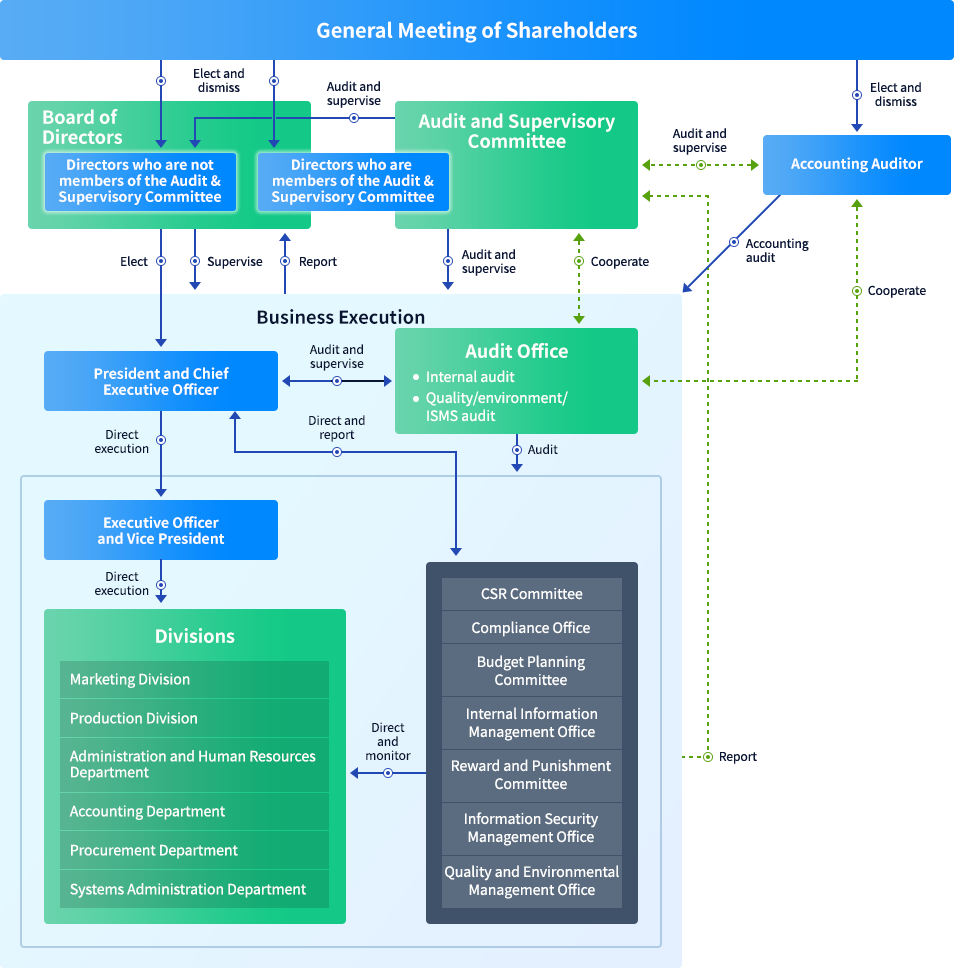Corporate Governance
Corporate Governance Structure
Basic Approach to Corporate Governance
Our policy is to strengthen corporate governance for sustainable value and market creation based on the values and ethics demanded by society. In particular, by ensuring management transparency and the timely and appropriate disclosure of information.
Overview of the Corporate Governance System and Reasons for its Adoption
Basic Information About Our Organization
JASTEC is a company with an Audit & Supervisory Committee and a Board of Directors.
Board of Directors
The Board of Directors, as the Company’s decision-making body, determines basic management policies and important matters, in addition to matters stipulated by laws and regulations and the Articles of Incorporation, and supervises the execution of directors’ duties. In principle, the Board of Directors meets once a month on a regular basis and also meets on an as-needed basis to facilitate prompt and efficient decision-making.
(Members of the Board of Directors)
Chairman: Hidetoshi Muranaka, President and Chief Executive Officer
Members:
Directors who are not members of the Audit & Supervisory Committee:
Shigeru Kamiyama, Hidetoshi Muranaka, Toshihiro Kawagoe, Hideo Gozu, Takamitsu Tani, Tatsuya Nobui
Directors who serve as members of the Audit & Supervisory Committee:
Tetsuya Obata, Minoru Matsumoto, Shinichirou Shimizu, Hanae Nakaya (all outside directors)
Audit & Supervisory Committee
The Audit & Supervisory Committee consists of four directors, Tetsuya Obata, Minoru Matsumoto, Shinichirou Shimizu, and Hanae Nakaya (all outside directors). In principle, the Audit & Supervisory Committee meets once a month on a regular basis and also meets on an as-needed basis to audit and supervise the execution of duties by directors.
(Members of the Audit & Supervisory Committee)
Chairman: Tetsuya Obata
Members: Tetsuya Obata, Minoru Matsumoto, Shinichirou Shimizu, Hanae Nakaya (all outside directors)
Our Business Execution and Supervision Structure
Democratic Management Practices
In order to increase transparency in overall management, establish a system of organizational and personnel checks and balances, and execute duties efficiently, the Company shares important management information, such as medium- to long-term business plans, annual budgets, and management issues, with directors and employees, in addition to providing opportunities for employees to make management proposals based on our proposal system. The Company also makes the personnel evaluation process clear and discloses evaluation results internally in order to ensure that the Company functions as a meritocracy and maintain fairness in personnel evaluations.
A Sound Board of Directors
At the regular monthly meetings of the Board of Directors, each department is requested to report on the progress of its business plans, fiscal year forecasts and related developments, thereby creating an environment where all directors can share information about problems and take countermeasures. These discussions and decisions are also widely disclosed to employees through the aforementioned democratic management practices.
Introduction of Executive Officer and Vice President System
The Company has introduced an executive officer and vice president system to clarify the distinction between the management decision-making function of the Board of Directors, with its monitoring and supervisory function and responsibility for business execution, and the business execution function and responsibility of executive officers and vice presidents.
Corporate Governance Structure Chart
The corporate governance structure is as follows.

- Business Risks
- Challenges to Be Addressed
Corporate Governance
IR Contact Information
Please direct inquiries concerning IR to the following address.
Depending on the nature of the inquiry, it may take some time before we are able to reply.
Thank you for your understanding in advance.
Inquiry hours: Weekdays 9:00—18:00, (except public holidays)
- ※JASTEC will not use personal information obtained through IR inquiries for any purpose other than replying to the inquiry, unless permission is granted by the individual making the inquiry.
